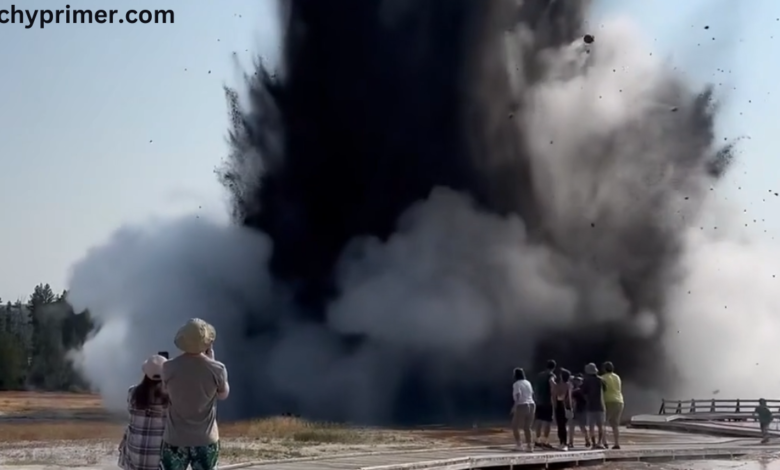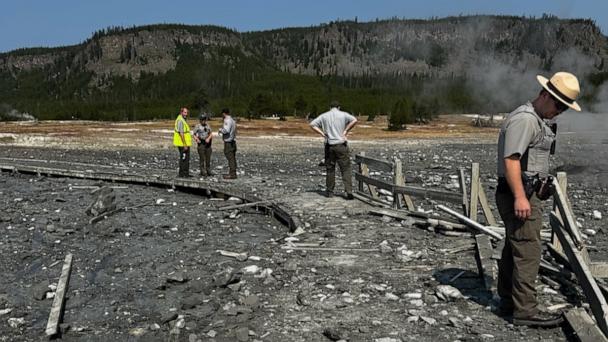The Yellowstone Explosion: Understanding the Supervolcano’s Potential

Introduction to yellowstone explosion Park
yellowstone explosion, established in 1872, holds a unique status as America’s first national park and a treasure trove of geological wonders. Spanning over 3,400 square miles, it sits atop a colossal supervolcano, the yellowstone explosion Caldera, which has captured the imaginations of scientists, tourists, and conspiracy theorists alike. With its stunning landscapes, diverse wildlife, and geothermal features like Old Faithful, Yellowstone is more than just a pretty picture; it’s a natural laboratory that provides insight into the Earth’s inner workings.
While the beauty of yellowstone explosion attracts millions of visitors each year, the underlying geology poses questions that often lead to conversations about the potential for a catastrophic volcanic explosion. This article delves deep into the science behind the yellowstone explosion supervolcano, exploring the implications of an explosion, the historical context of past eruptions, and what it all means for our future.
The Geology of yellowstone explosion: What Lies Beneath
Formation of the yellowstone explosion Caldera

The yellowstone explosion supervolcano was formed over millions of years through a series of catastrophic eruptions. The last major eruption occurred approximately 640,000 years ago, creating the massive caldera that we see today. This caldera is not a traditional volcano; it’s a giant crater formed when a volcano erupts and collapses in on itself. The geological processes that led to its formation are complex, involving the movement of magma from deep within the Earth’s mantle.
Over the years, the caldera has undergone several phases of volcanic activity, with each eruption significantly altering the landscape. The evidence of past eruptions is still visible in the park’s geothermal features, such as hot springs, mud pots, and fumaroles. These features serve as constant reminders of the immense power that lies beneath the surface.
Magma Movement and Heat Flow
Understanding the heat flow and magma movement beneath yellowstone explosion is crucial to assessing the potential for an yellowstone explosion. The Yellowstone hotspot, a plume of hot magma rising from deep within the Earth, is responsible for the park’s geothermal activity. This plume generates significant heat, causing the melting of rocks and the accumulation of magma in reservoirs beneath the surface.
Seismologists and geologists monitor these magma movements closely. By using advanced technologies, they can track the shifting of magma and the resulting seismic activity. In recent years, there has been increased interest in how these movements might indicate an impending eruption. While there is no direct evidence that a major eruption is imminent, the dynamic nature of the magma beneath yellowstone explosion is a constant subject of study.
Geological Indicators of Volcanic Activity
Scientists rely on various geological indicators to assess the health of the yellowstone explosion supervolcano. These indicators include ground deformation, gas emissions, and seismic activity. Ground deformation, for instance, occurs when magma accumulates underground, causing the surface to swell. This phenomenon has been observed in Yellowstone, with areas of the park experiencing noticeable elevation changes.
Gas emissions, particularly sulfur dioxide, can also signal volcanic unrest. Increased levels of these gases can indicate that magma is moving closer to the surface. Additionally, monitoring seismic activity helps scientists detect minor earthquakes that often precede volcanic eruptions. By analyzing these factors, researchers can gain insight into the likelihood of future eruptions.
Historical Eruptions: A Look Back
The Three Major Eruptions
The yellowstone explosion supervolcano has experienced three major eruptions in the last 2.1 million years, with the most significant events occurring roughly 2.1 million, 1.3 million, and 640,000 years ago. Each of these eruptions had far-reaching effects on the environment, climate, and ecosystems both locally and globally.
The oldest eruption, known as the Huckleberry Ridge eruption, released an estimated 2,500 cubic kilometers of material into the atmosphere. This massive explosion was one of the largest volcanic events in Earth’s history and led to dramatic changes in the landscape, forming much of what we now see in Yellowstone.
The subsequent eruptions, the Mesa Falls eruption, and the Lava Creek eruption, were also monumental in scale, contributing to the park’s unique geological features. Each eruption left behind layers of volcanic ash and rock that tell a story of the Earth’s geological past. These layers can be studied to understand the conditions leading up to each explosion and the aftermath, providing valuable insights into potential future events.
The Impact of Past Eruptions
The impact of these historical eruptions extended beyond Yellowstone. The Huckleberry Ridge eruption, for example, produced ash that traveled thousands of miles, affecting air quality and climate patterns across North America. This kind of volcanic activity can lead to what’s known as “volcanic winter,” where the injection of ash and sulfuric gases into the stratosphere results in cooler temperatures.
These eruptions also had profound effects on the local ecosystems. The immediate vicinity of the caldera would have been devastated, with plants and animals struggling to survive in the harsh, ash-laden environment. However, over time, life would rebound, illustrating the resilience of nature. The cycles of destruction and rebirth are crucial for understanding how ecosystems adapt to such cataclysmic events.
Lessons from History: What Can We Learn?
Studying the history of Yellowstone’s eruptions offers valuable lessons for contemporary society. One critical takeaway is the importance of monitoring geological activity. While we cannot predict eruptions with absolute certainty, understanding the patterns of past activity can help inform preparedness strategies for potential future events.
Additionally, these historical perspectives remind us of the Earth’s dynamic nature. While we may feel a sense of stability in our modern world, the reality is that geological processes are always at work beneath our feet. This understanding encourages a deeper appreciation for natural systems and the need for ongoing research and monitoring.
The Science of Eruption Prediction
Modern Techniques in Volcanology
Volcanology has advanced significantly since the days when eruptions were viewed as mere acts of nature. Today, scientists employ a variety of techniques to monitor and predict volcanic activity. Remote sensing technology, for instance, allows researchers to track ground deformation and temperature changes in real-time. Satellites equipped with infrared sensors can detect thermal anomalies that may indicate rising magma.
Seismology plays a crucial role as well. By analyzing earthquake patterns, scientists can identify swarms of seismic activity that may precede an eruption. These swarms can signal the movement of magma through the crust, providing essential data for assessing volcanic risk. The integration of multiple monitoring techniques helps create a comprehensive picture of the supervolcano’s health.
Challenges in Eruption Forecasting
Despite the advances in technology, predicting volcanic eruptions remains a complex challenge. The behavior of a supervolcano like yellowstone explosion can be unpredictable. While scientists have made significant strides in understanding the warning signs, there is still much to learn about the processes at play.
One major challenge is the long timescale of geological processes. Changes can occur over years, decades, or even centuries, making it difficult to pinpoint the exact timing of an eruption. Furthermore, not all eruptions are preceded by clear indicators, leading to potential gaps in knowledge. This uncertainty underscores the importance of ongoing research and investment in monitoring systems.
Community Preparedness and Response
Given the potential for a yellowstone explosion, community preparedness is essential. Local and federal agencies have developed response plans that outline evacuation routes, communication strategies, and resource management in the event of a volcanic crisis. Public education campaigns also play a vital role in ensuring that residents and visitors understand the risks and know what to do in an emergency.
Awareness is key. By educating the public about the signs of volcanic unrest and the importance of emergency preparedness, communities can enhance their resilience to natural disasters. Engaging with scientists and local authorities helps foster a collaborative approach to managing the risks associated with living near a supervolcano.
The Potential Consequences of an Explosion
Immediate Local Impact
If a major eruption were to occur at Yellowstone, the immediate local impact would be devastating. The explosion would likely produce a massive ash cloud, obliterating everything within a certain radius. Hot pyroclastic flows could travel down the sides of the caldera, incinerating flora and fauna in their path. The landscape would be irrevocably altered, and local communities would face significant challenges in the aftermath.
Air quality would also deteriorate drastically. The ash fallout could blanket nearby towns, leading to health risks for residents and disrupting daily life. Infrastructure such as roads, bridges, and utilities could be severely damaged or destroyed, complicating evacuation and recovery efforts. The scale of devastation would necessitate an immediate and coordinated response from emergency services and government agencies.
Regional and Global Effects
The ramifications of a yellowstone explosion wouldn’t be confined to the park or even the United States. Ash clouds could drift across vast distances, impacting air travel and affecting climate patterns globally. The release of sulfur dioxide into the atmosphere could lead to a volcanic winter, causing dramatic drops in temperature and altering weather systems.
Agricultural production could suffer, resulting in food shortages and economic instability. The interconnectedness of global supply chains means that regions far from yellowstone explosion could feel the effects of an eruption in various ways. Understanding these potential consequences is crucial for formulating comprehensive disaster response plans.
Long-Term Ecological Changes
In the long term, the ecological changes resulting from an eruption could be profound. While initial devastation would create a hostile environment for life, ecosystems often rebound remarkably well over time. The ash and volcanic material can enrich the soil, promoting new growth and fostering biodiversity.
Studies of past eruptions suggest that, while certain species may go extinct, new species often emerge in the wake of such events. The process of ecological succession can lead to the establishment of entirely new ecosystems, illustrating the resilience of nature. Understanding these dynamics can help scientists predict how ecosystems might evolve after a volcanic event.





